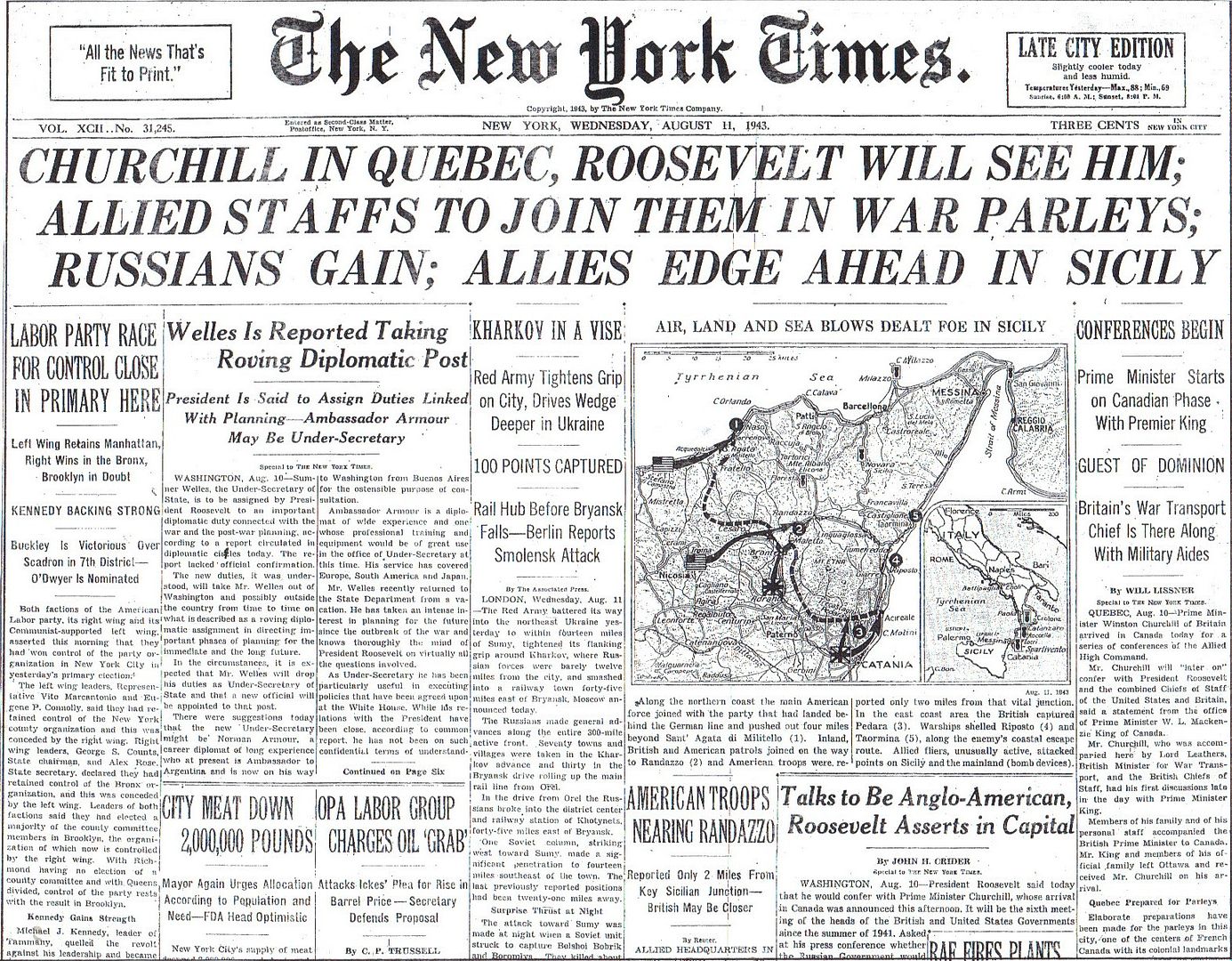
Posted on 08/11/2013 5:57:07 AM PDT by Homer_J_Simpson

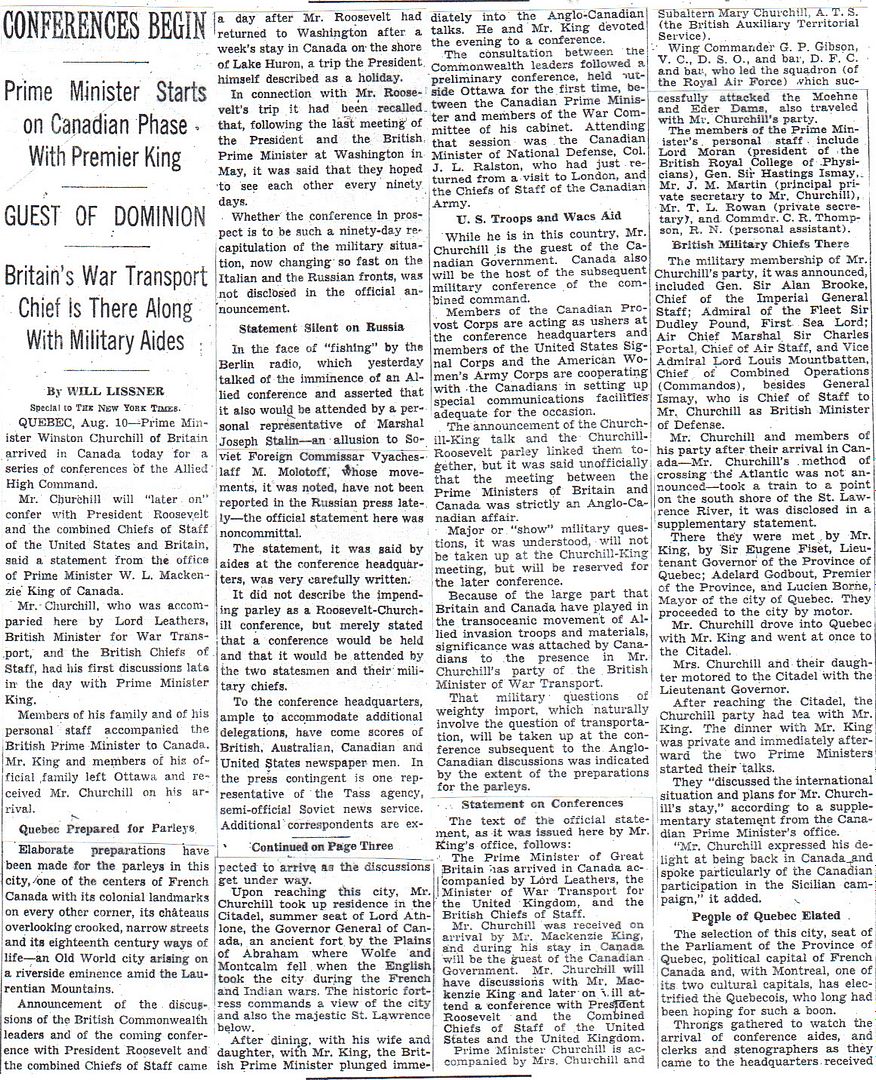
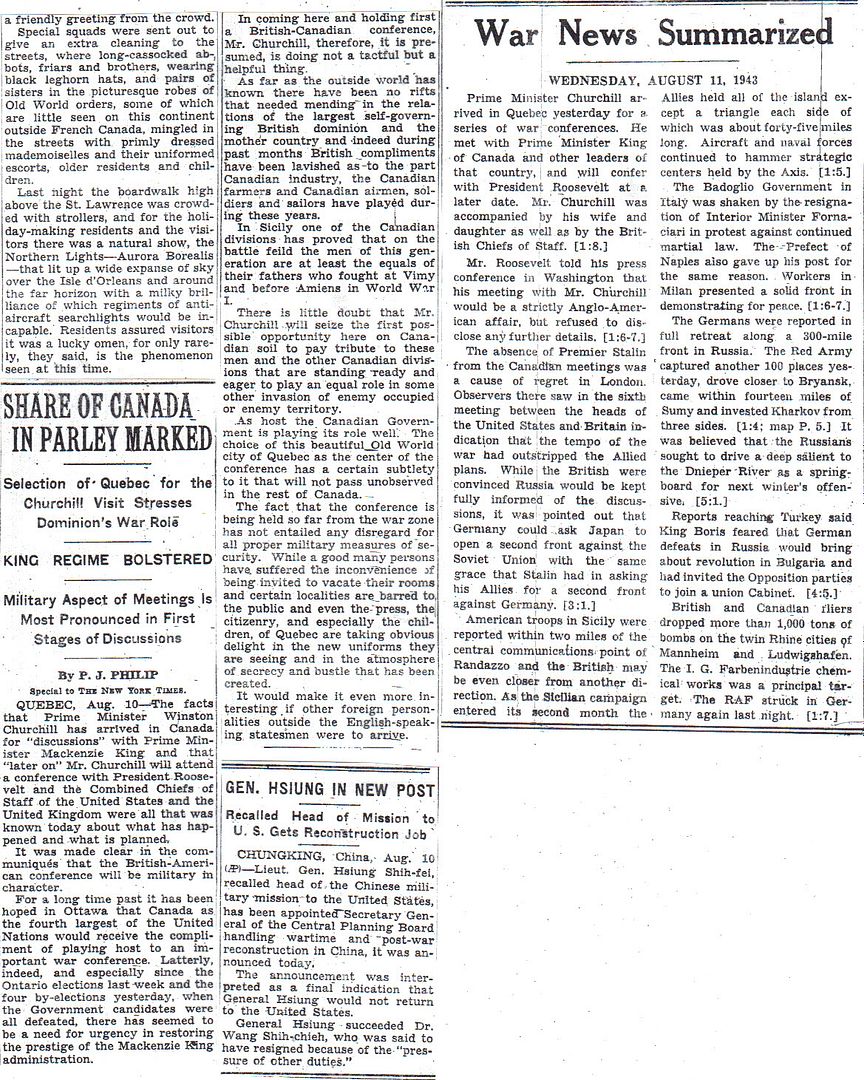
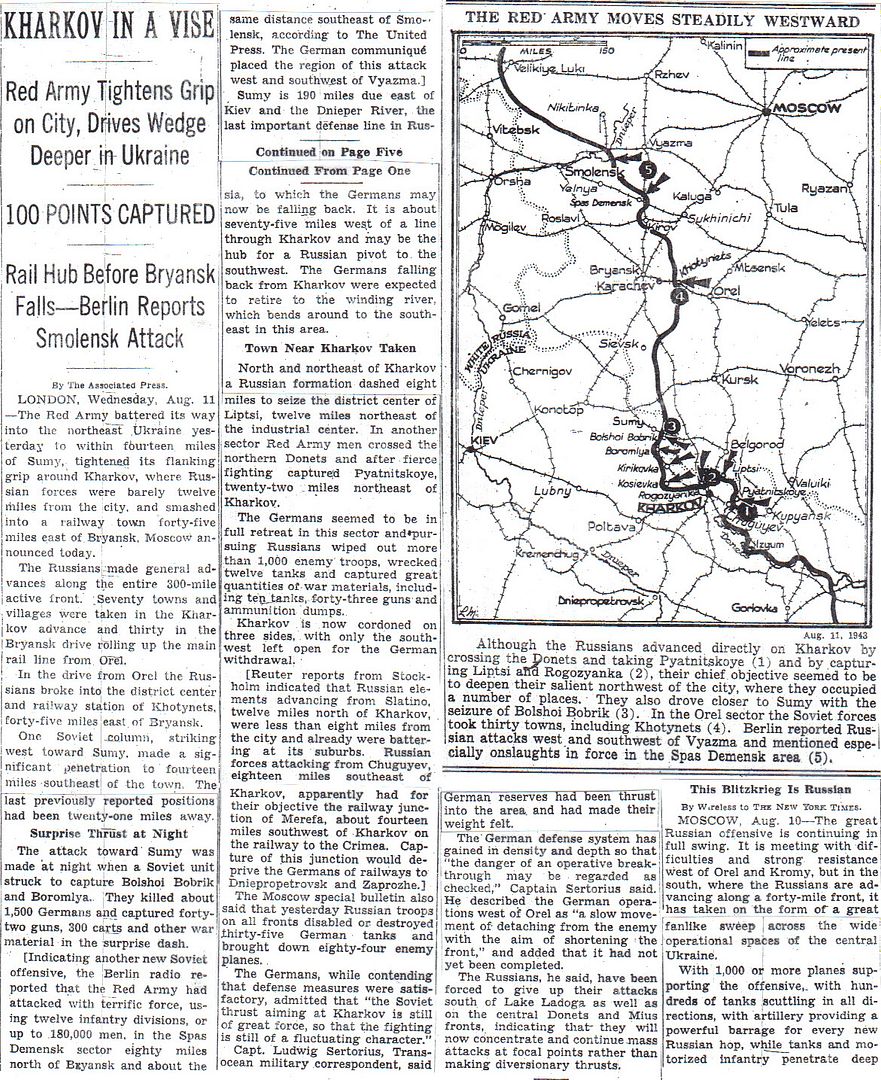

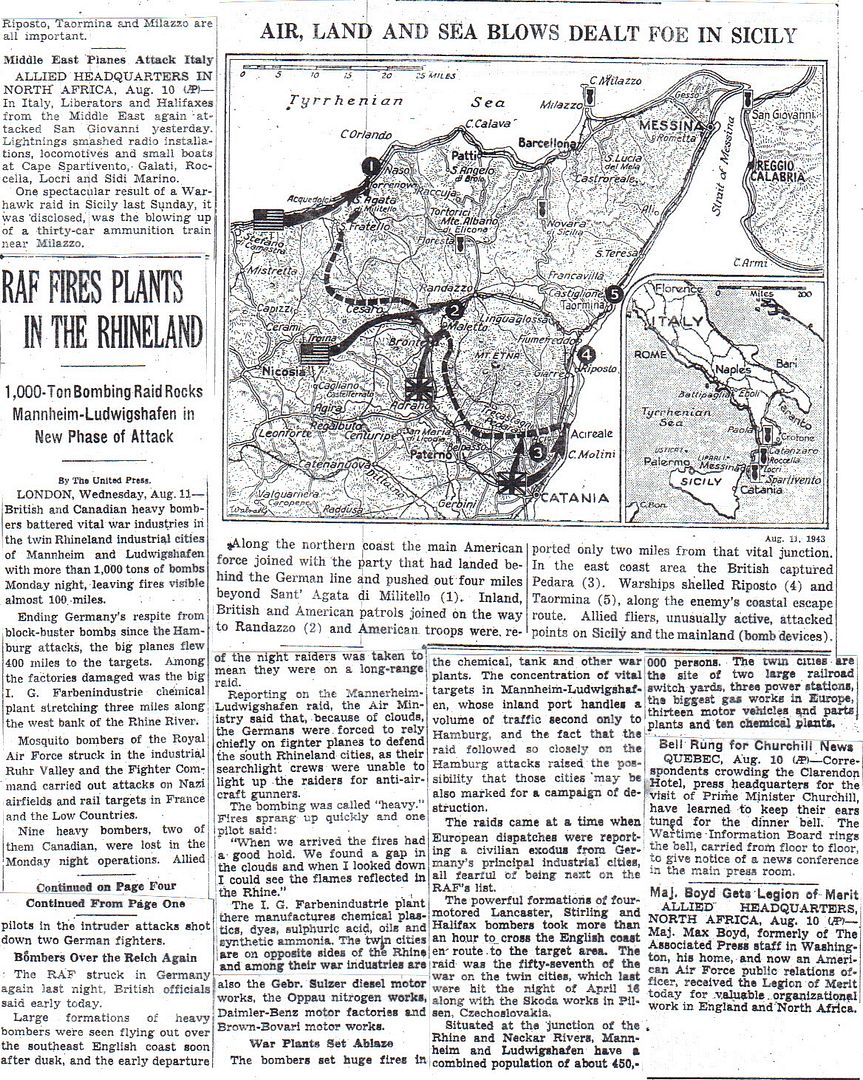
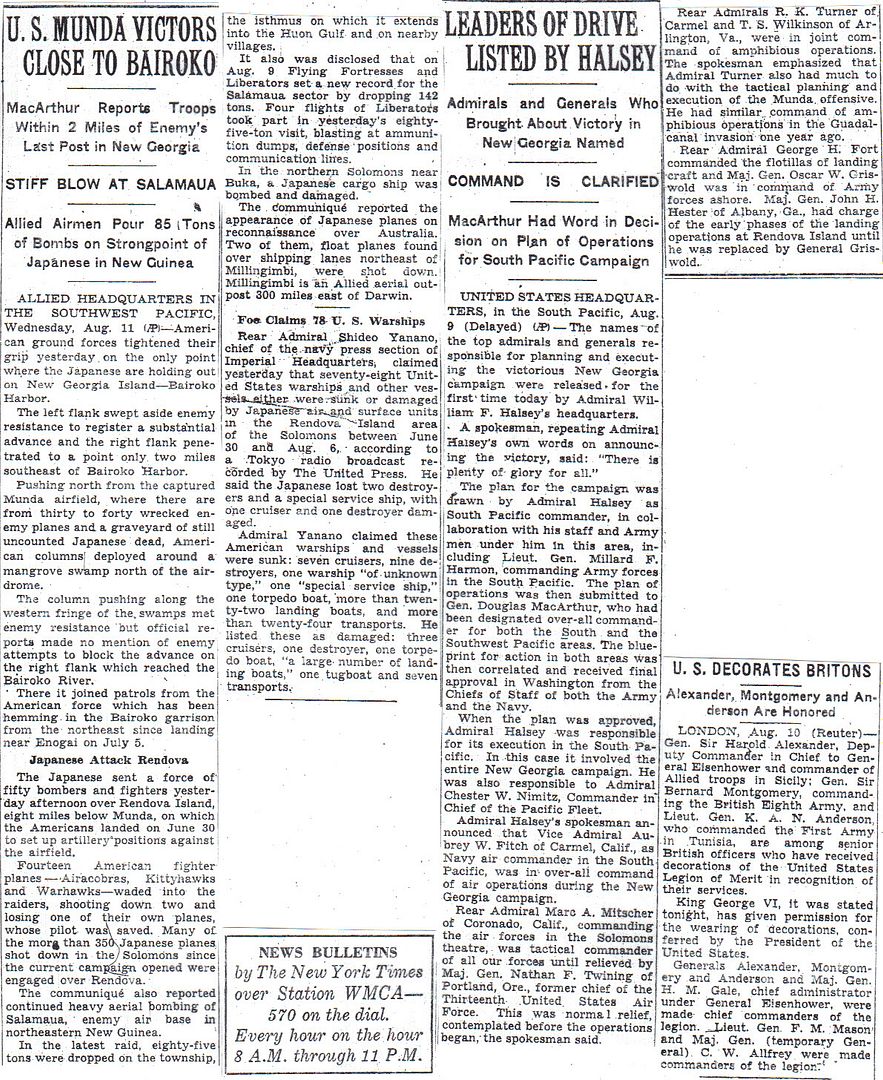
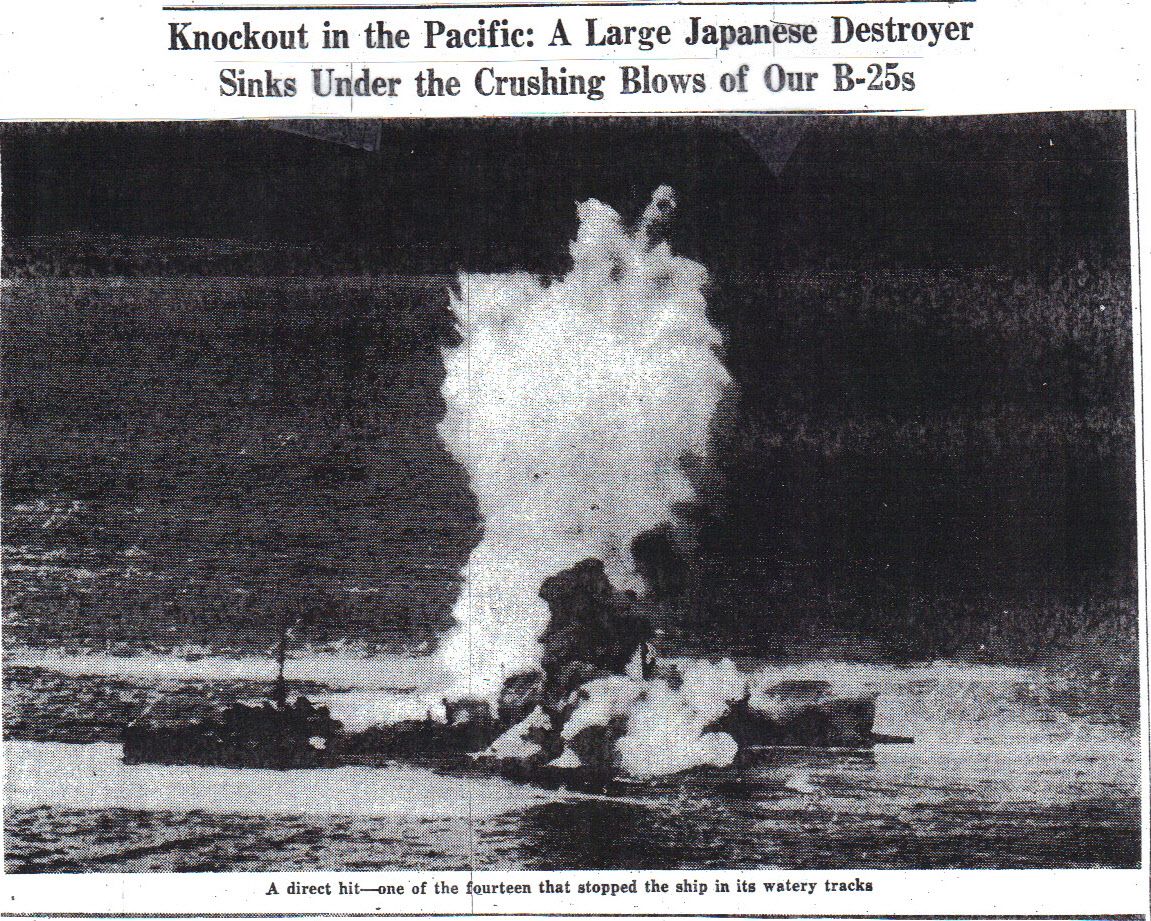
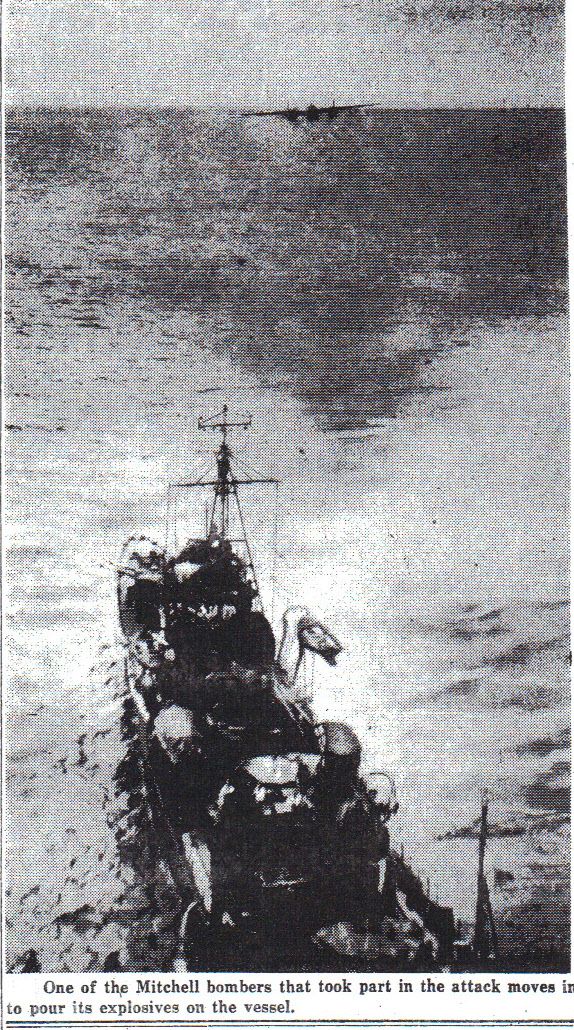
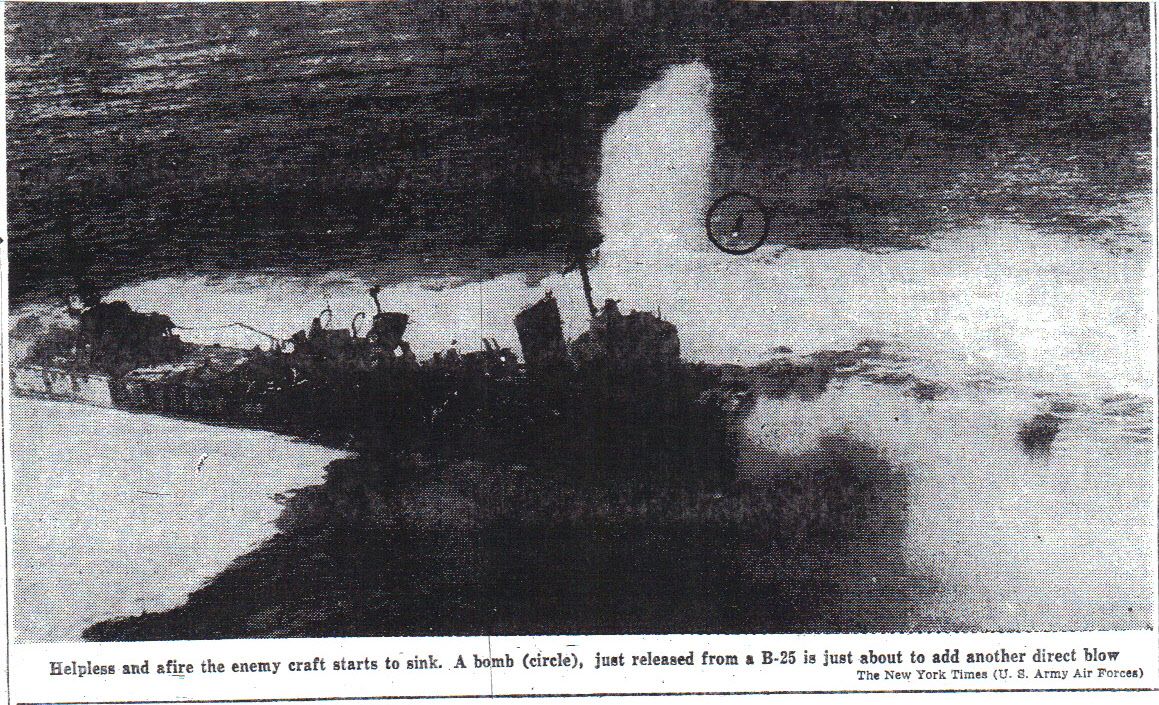
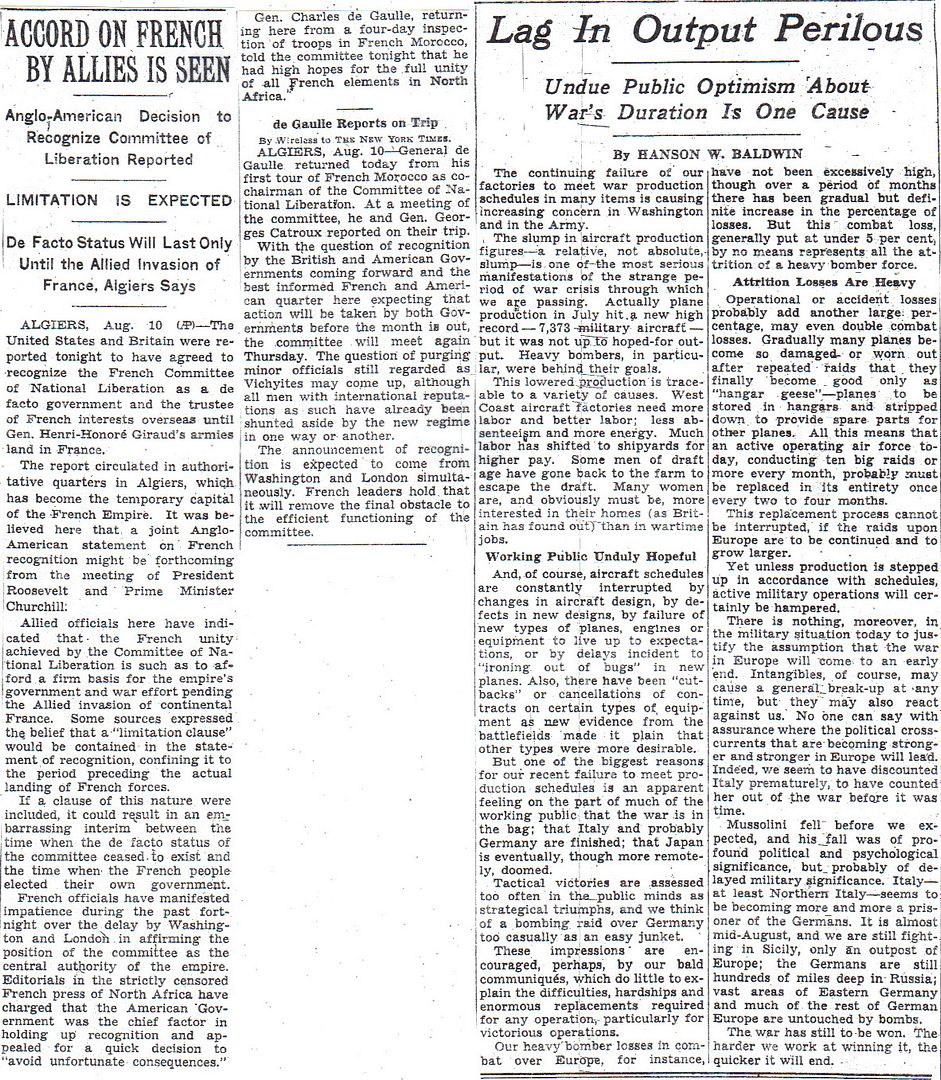
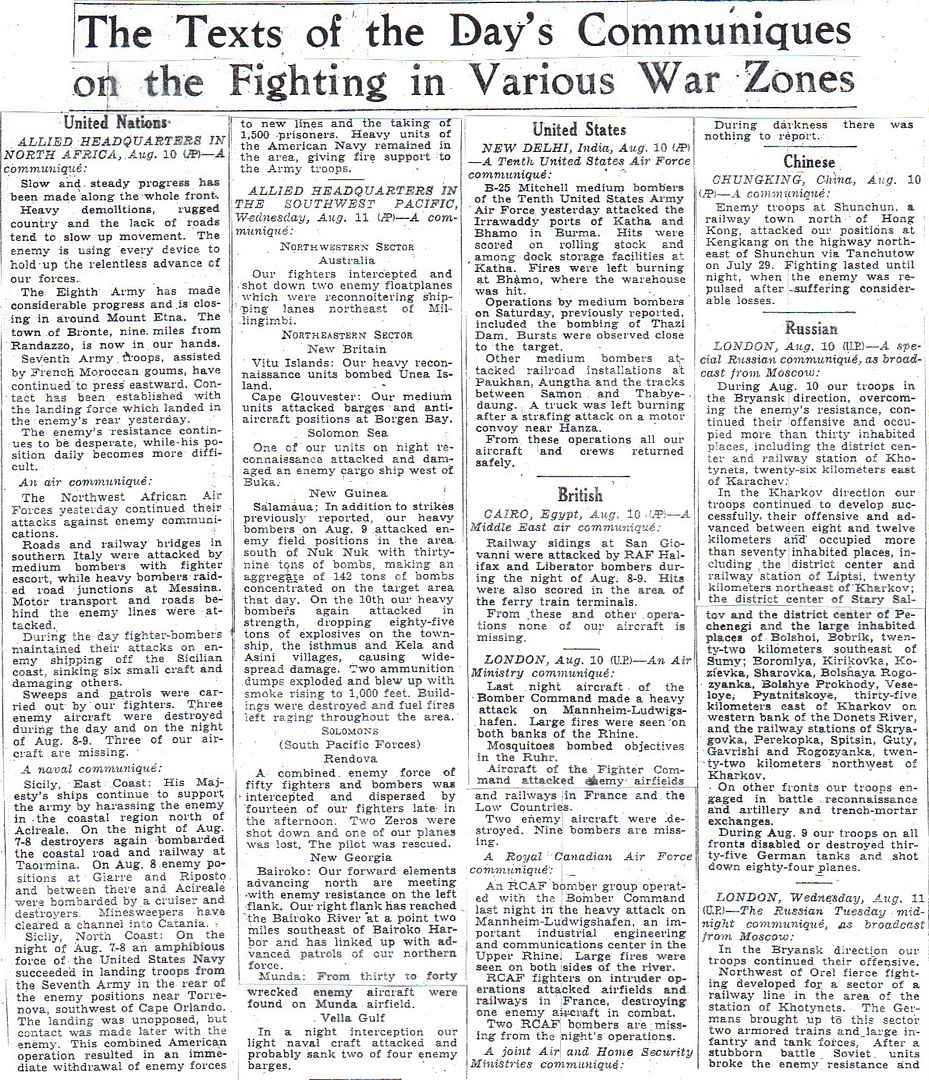

Conferences Begin (Lissner) – 2-3
Share of Canada in Parley Marked (Philip) – 3
War News Summarized – 3
Kharkov in a Vise – 4-5
American Troops Nearing Randazzo (Bracker) – 5-6
RAF Fires Plants in the Rhineland – 6
U.S. Munda Victors Close to Bairoko – 7
Leaders of Drive Listed by Halsey – 7
Knockout in the Pacific: A Large Japanese Destroyer Sinks Under the Crushing Blows of Our B-25s (photos) – 8-10
Accord on French by Allies is Seen – 11
Lag in Output Perilous (Baldwin) – 11
The Texts of the Day’s Communiques on the Fighting in Various War Zones – 12-13
http://www.onwar.com/chrono/1943/aug1943/f11aug43.htm
Soviet troops fighting west of Kharkov
Wednesday, August 11, 1943 www.onwar.com
On the Eastern Front... Red Army forces cut the Poltava-Kharkov railroad about 30 miles west of Kharkov.
http://www.etherit.co.uk/month/thismonth/11.htm
August 11th, 1943 (WEDNESDAY)
UNITED KINGDOM: Escort carrier HMS Slinger commissioned.
Frigate HMS Cosby laid down.
Minesweeper HMS Harrier is laid down.
GERMANY: U-1221 commissioned.
U.S.S.R.: 30 miles west of Kharkov the Red Army cuts the Poltava—Kharkov railroad.
ITALY: Last night another landing on Sicily, east of Cape Orlando, at Brolo is made by US forces. The Germans fall back quickly.
German forces begin a six-day evacuation of Sicily. Over the next six days and seven nights, the Germans evacuated 39,569 troops, 47 tanks, 94 heavy guns, 9,605 vehicles and 2,000+ tons of ammunition to Italy from Messina. In addition, 60,000 Italian troops were evacuated.
MEDITERRANEAN SEA: Submarine HMS Parthian mined and sunk.
SOLOMON ISLANDS: Admiral Halsey orders the occupation of Japanese bases on Vella Lavella.
5 US Thirteenth Air Force B-24s hit a supply area on the eastern side of Suavanau Point, Santa Isabel Island and on Papatura Fa Island. ‘
TERRITORY OF ALASKA: In the Aleutian Islands, the US Eleventh Air Force dispatches B-24s, B-25 Mitchells, A-24 Dauntlesses, and P-38 Lightnings to pound Kiska Island targets in 11 attack missions; later, 10 reconnaissance, strafing and photo missions to Kiska are flown by 3 P-38s, 26 P-40s, 4 F-5A Lightnings and a B-24. In the Kurile Islands, 9 B-24s from Attu Island drop bombs and incendiaries on Paramushiru Island, including Kashiwabara Airfield and Shimushu Island where the Kataoka naval base and staging area are hit. 40 enemy aircraft challenge the attackers, which score 4 confirmed kills, 1 probable, and 4 possible.
CANADA: The Quebec Conference begins. President Franklin D Roosevelt and Prime Minister Winston S Churchill discuss the entire spectrum of world operations and decide on the future action of Anglo-US armed forces.
Destroyer HMCS Hamilton assigned HMCS Cornwallis for training duties.
U.S.A.: Minesweeper USS Harrier laid down.
Destroyer escorts USS Hayter and Hubbard laid down.
Destroyer escort USS George W Ingram commissioned.
ATLANTIC OCEAN: Three German submarines are sunk:
- U-468 is sunk near Bathurst, Gambia, in position 12.20N, 20.07W, by depth charges from an RAF Liberator Mk V of No 200 Squadron based at Yundum, Gambia; the Liberator was shot down by the U-boat crew. 7 of the 51 U-boat crewmen survive. F/O Lloyd Alan Trigg (b.1914), RNZAF, attacked this U-boat while on patrol. The U-boat fought back with its anti-aircraft guns, inflicting fatal damage on the aircraft. He died when his bomber was shot down by blistering anti-aircraft fire, but the U-boat sank soon after. (Victoria Cross)
- U-525 is sunk about 376 miles (605 km) west-southwest of the Azores, in position 41.29N, 38.55W, by depth charges and aerial torpedoes from a TBF Avenger and an F4F Wildcat of Composite Squadron One (VC-1) in the US escort aircraft carrier USS Card (CVE-11). All hand on the U-boat, 54-men, are lost.
- U-604 is scuttled by her crew in the South Atlantic, in position 04.30S, 21.20W. The U-boat had been severely damaged by 4 Mark 47 depth charges from a USN PV-1 Ventura of Bombing Squadron One Hundred Twenty Nine (VB-129) based at NAF Ipitanga, Bahia, Brazil on 30 July. The crew of the PV-1 had spotted the U-boat on the surface and after attacking, the U-boat had submerged, resurfaced and submerged again. On 3 August, U-604 was again attacked by PB4Y-1 Liberators of Patrol Squadron One Hundred Seven (VP-107) based at NAF Natal, Brazil and the destroyer USS Moffett (DD-362). The U-boat is so damaged that her crew scuttles her and they are taken aboard U-172 and U-185 for the voyage home. During the rescue U-172 is attacked by an American Liberator aircraft from Squadron VB-107, one man from its crew is killed [Maschinenobergefreiter Fritz Schiemann]. 31 of the 45-man crew survives. (Jack McKillop and Dave Shirlaw)
U-64 Scuttled 11 Aug, 1943 in the South Atlantic, in position 04.30S, 21.20W, after being badly damaged by depth charges from 2 American aircraft, a Ventura (VB-129) and a Liberator (VB-107). 14 dead and 31 survivors.
Canada Ping!
AS PROFICIENT AS A CIRCUSSource: http://journalism.indiana.edu/resources/erniepyle/wartime-columns/as-proficient-as-a-circus/SOMEWHERE IN SICILY, August 11, 1943 – Probably it isn’t clear to you just how the Army’s setup for the care of the sick and wounded works on a battlefront. So I’ll try to picture it for you.
Let’s take the medical structure for a whole division, such as the 45th, which I have been with recently. A division runs roughly fifteen thousand men. And almost a thousand of that number are medical men.
To begin right at the front, three enlisted medical-aid men go along with every company. They give what first aid they can on the battlefield. Then litter-bearers carry the wounded back to a battalion aid station.
Sometimes a wounded man is taken back right away. Other times he may be pinned down by fire so that the aid men can’t get to him, and he will have to lie out there for hours before help comes. Right there in the beginning is the biggest obstacle, and the weakest feature of the army’s medical setup.
Once a soldier is removed from the battlefield his treatment is superb. The battalion aid station is his first of many stops as he is worked to the rear and finally to a hospital. An aid station is merely where the battalion surgeon and his assistant happen to be. It isn’t a tent or anything like that – it’s just the surgeon’s medical chest and a few stretchers under a tree. Each station is staffed by two doctors and thirty-six enlisted men. They are very frequently under fire.
At an aid station a wounded man gets what is immediately necessary, depending on the severity of his wounds. The idea all along is to do as little actual surgical work as possible, but at each stop merely to keep a man in good enough condition to stand the trip on back to the hospital, where they have full facilities for any kind of work. Hence if a soldier’s stomach is ripped open they do an emergency operation right at the front but leave further operating to be done at a hospital. If his leg is shattered by shrapnel they bind it up in a metal rack, but the operating and setting isn’t done till he gets back to the hospital. They use morphine and blood plasma copiously at the forward stations to keep sinking men going.
*
From the battalion aid station the wounded are taken by ambulance, jeep, truck or any other means back to a collecting station. This is a few tents run by five doctors and a hundred enlisted men, anywhere from a quarter of a mile to several miles behind the lines. There is one collecting station for each regiment, making three to a division.
Here they have facilities for doing things the aid station can’t do. If the need is urgent they redress the wounds and give the men more morphine, and they perform quite a lot of operations. Then the men are sent by ambulance on back to a clearing station.
The 45th Division has two clearing stations. Only one works at a time. While one works, the other takes a few hours’ rest, then leapfrogs ahead of the other one, sets up its tents and begins taking the patients. In emergencies both clearing stations work at once, temporarily abandoning their rest-and-leapfrog routine.
All these various crews – the company aid men, the battalion aid station, the collecting station and the clearing station – are all part of the division. They move with it, fight when it does, and rest when it does.
*
Then back to the clearing stations the hospitals begin. The first hospitals are usually forty miles or more back of the fighting. The hospitals are separate things. They belong to no division, but take patients from everywhere.
They get bigger as you go back, and in the case of Sicily patients are evacuated from the hospitals right onto hospital ships and taken back to still bigger hospitals in Africa.
The main underlying motive of all front-line stations is to get patients evacuated quickly and keep the decks clear so they will always have room for any sudden catastrophic run of battle casualties.
A clearing station such as the one I was in is really a small hospital. It consists of five doctors, one dentist, one chaplain, and sixty enlisted men. It is contained in six big tents and a few little ones for the fluroscope room, the office, and so forth. Everybody sleeps outdoors on the ground, including the commanding officer. The mess is outdoors under a tree.
The station can knock down, move, and set up again in an incredibly short time. They are as proficient as a circus. Once, during a rapid advance, my station moved three times in one day.
Great post. Thanks.
Thanks for the post.
Disclaimer: Opinions posted on Free Republic are those of the individual posters and do not necessarily represent the opinion of Free Republic or its management. All materials posted herein are protected by copyright law and the exemption for fair use of copyrighted works.